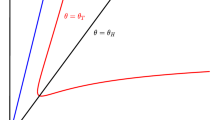Abstract
We study a general predator—prey system in a spatially heterogeneous environment. The predation process, which occurs on a behavioural time-scale, is much faster than the other processes (reproduction, natural mortality and migrations) occurring on the population dynamics time-scale. We show that, taking account of this difference in time-scales, and assuming that the prey have a refuge, the dynamics of the system on a slow time-scale become donor-controlled. Even though predators may control the prey density locally and on a behavioural fast time-scale, nevertheless, both globally and on a slow time-scale, the prey dynamics are independent of predator density: the presence of predators generates a constant prey mortality. In other words, in heterogeneous environments, the prey population dynamics depend in a switch-like manner on the presence or absence of predators, not on their actual density.
Similar content being viewed by others
References
Arditi, R. and L. R. Ginzburg (1989). Coupling in predator—prey dynamics: ratio-dependence. J. Theor. Biol. 139, 311–326.
Arditi, R. and H. Saïah (1992). Empirical evidence of the role of heterogeneity in ratio-dependent consumption. Ecology 73, 1544–1551.
Auger, P. M. and J. C. Poggiale (1996). Emergence of population growth models: fast migrations and slow growth. J. Theor. Biol. 182, 99–108.
Berryman, A. A., J. Michalski, A. P. Gutierrez, and R. Arditi (1995). Logistic theory of food web dynamics. Ecology 76, 336–343.
Chow, S. N., C. Lie, and D. Wang (1994). Normal Forms and Bifurcation of Planar Vector Fields, Cambridge: Cambridge University Press.
Fenichel, N. (1971). Persistence and smoothness of invariant manifolds for flows. Indiana Univ. Math. J. 21, 193–226.
Gause, G F. (1934). The Struggle for Existence, New York: Hafner Publishing Co.
Getz, W. M. (1991). A unified approach to multispecies modeling. Nat. Res. Mod. 5, 393–421.
Hairston, N., F. Smith, and L. Slobodkin (1960). Community structure, population control and competition. Am. Nat. 94, 421–425.
Hanski, I. (1991). The functional response of predators: worries about scale. Trends Ecol. Evol. 6, 141–142.
Hawkins, B. A. (1992). Parasitoid—host food webs and donor control. Oikos 65, 159–162.
Holling, C. S. (1959). Some characteristics of simple types of predation and parasitism. Can. Entom. 91, 385–398.
Huffaker, C. B. (1958). Experimental studies on predation: dispersion factors and predator—prey oscillations. Hilgardia 27, 343–383.
Luckinbill, L. S. (1973). Coexistence in laboratory populations of Paramecium aurelia and its predator Didinium nasutum. Ecology 54, 1320–1327.
Luckinbill, L. S. (1974). The effect of space and enrichment on a predator—prey system. Ecology 55, 1142–1147.
Menge, B. A. (1992). Community regulation: under what conditions are bottom—up factors important on rocky shores? Ecology 73, 755–765.
Michalski, J., J.-Ch. Poggiale, R. Arditi, and P. M. Auger (1997). Macroscopic dynamic effects of migrations in patchy predator—prey systems. J. Theor. Biol. 185, 459–474.
Pimm, S. L. (1982). Food Webs, London and New York: Chapman and Hall.
Strong, D. R. (1992). Are tropic cascades all wet? Differentiation and donor-control in specious ecosystems. Ecology 73, 747–754.
Author information
Authors and Affiliations
Rights and permissions
About this article
Cite this article
Poggiale, J.C., Michalski, J. & Arditi, R. Emergence of donor control in patchy predator—prey systems. Bull. Math. Biol. 60, 1149–1166 (1998). https://doi.org/10.1006/S0092-8240(98)90006-4
Received:
Accepted:
Issue Date:
DOI: https://doi.org/10.1006/S0092-8240(98)90006-4




